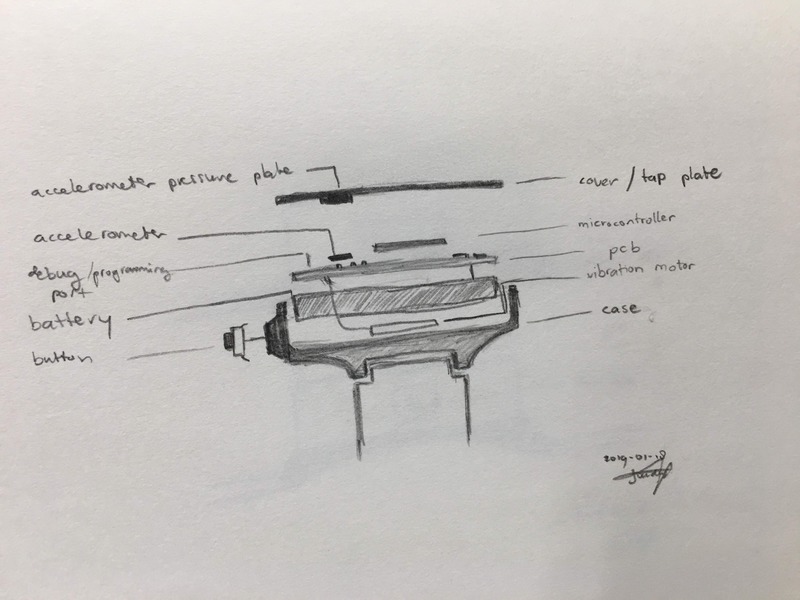
Week 1. Concept final project
1. Start on final project concept
version 2019-03-29
Accessible smartwatch for people with a visually impairment.
Personal Internet of things devices are becoming more common (e.g. smarthome, health, sports).
The accessibility of these devices is often low, user groups as visually impaired are not supported or even considered when the hardware and software is designed and implemented. While Apple devices do support accessibility via Voice-over this is not always implemented in the apps. Still when implemented it results in the VI having to rely on the text-to-speech interface. The TTS/voice interface demands the full attention of the VI when using the device, making it very difficult to interact with other people while interaction with the device. This demand on voice interfaces can be greatly reduces by implemented haptic based input and output. Unfortunately Apple Watches do not allow for advanced haptic feedback.
We envision a smart wearable optimised for delivering haptic in- and output for VI. By starting with presenting notifications via vibrations and input via buttons and tap patterns, we believe we can create a small, affordable and flexible wearable that is easy to use by VI.
It can be further extended with traditional VI output systems as touchable hands of a clock and braille.
Research
Vibrating armbands
Basslet
Anne has a Basslet, a vibrating wearable armband that vibrates on the bass of music, that I could borrow from her to explore its workings.
The Basslet is made bij lofelts. It does not have an API, you can just use it for vibrating on sound. So I decided to fiddle a bit with it to explore its capabilities of vibrations.
I tried it out with several songs. And found the respons ….
And then explored different vibrations, with different bass levels in Audacity.
With these different bass levels I tried to create different vibration patterns.
Existing accessible smart watches
Dotwatch
A braille connected watch. Also supports indicating time in dots instead of braille. Features: buttons, vibration and displays messages and notifications.
Battery life 10 days.
Source: https://www.dotincorp.com/
Apple Watch
Only accessible via Voice-over, text to speech interface with touchscreen.
Can run apps and displays notifications.
Features: vibration, gps, WiFi, accelerometer, compass, heart rate, touchscreen,
Battery life : about a week
Google wear watches
Comparable to Apple watch
Existing accessible watches
Existing accessible watches are available in two types: tactile clocks (via braille or toucheable indicators), and electronic audio (voice).
Both types are commonly used, but tactile watches have been the most popular in the past.
Examples at: https://www.worldwidevision.nl/uurwerken/horloge/
Existing hybrid watches
There are several companies extending existing watches with smartwatch features as heart rate sensor, stepcounter. An example are the Fossil hybrid watches. Fossil hybrid watches have analogue clocks and support vibrations, have a special dial to indicate a feature and customisable buttons. It also contains sensors as step counter, heart rate. They are Bluetooth connected and can last for 1 year on a single battery. Source https://www.fossil.com/us/en/wearable-technology/smartwatches/hybrids-learn-more.html
Accessible IoT applications explored
Accessible doorbell
Together with Bartimeus we created several protoypes of an accessible doorbell system for visual and audible impaired users. The system uses a finger print scanner as doorbell to detect who is at the door. A raspberry pi controlls the sensors and provides the logic. A smartphone app communicates with the raspberry pi and sends data to the smartwatch. The smartwatch communicates the data via vibration patterns, colors and text. We found during these projects that only a limited amount of vibration patterns could be created on the smartwatches, due to limitations of the Google Wear platform.
EyeBeacons
A smartwatch app communicates wayfinding information via text, icons and vibration patterns to the user on the Apple Watch. We found that due to the limitations of the WatchOS platform we could only provide a limited amount of vibration patterns and intensities.
Requirements
- Recognise tap gestures via accelerometer
- Vibrations as output
- Has at least one button
- Bluetooth connected to phone
- Can work standalone as watch (maybe support WiFi)
- LED indicators (for debugging)
- USB-port for power and programming
- Uses (rechargeable) battery
- Long battery life: last at least a day preferable a week or longer
Gallery
Initial sketches of accessible smartwatch concept:



Planning
- Jan 31: Fusion360 course by Mauro.: Design of case for prototype board. Normal arm form and to allow for elastic bands.
- Feb 06: computer-controlled cutting: Cut designed prototype case from cardboard/paper
- Feb 13: electronics production: Development of prototype board
- Feb 20: 3D scanning and printing: Print components or full case for prototype board.
- Feb 27: electronics design: Further development of prototype board
- Mar 06: computer-controlled machining: Further develop new version of prototype board case.
- Mar 13: embedded programming: Further development of prototype board software, extend with (more) sensors, bluetooth communication with smartphone,
- Mar 20: molding and casting: Make the perfect fit armband
- Mar 27: input devices: Implement tab gestures
- Apr 03: output devices: Invest in vibrations
- Apr 10: applications and implications: Further develop smartphone app and online platform
- Apr 24: networking and communicationsL Or Bluetooth as network communication further optimise protocol to reduces power usage. Otherwise Wifi for direct internet.
- May 01: mechanical design: some flying contraption? or marble machine doorbell?
- May 08: interface and application programming: Further develop smartphone app and online platform
- May 15: machine design: some flying contraption? or marble machine doorbell?
- May 22: wildcard week?
- May 29: invention, intellectual property, and income: Develop a plan for dissemination of your final project
- Jun 05: project development: compete final project
- Jun 12: project presentations: present final project
Materials
- Microcontroller
- Accelerometer
- Vibration motor
- button(s)
- Bleutooth chip
- Bluetooth antenna (on PCB?)
- Battery
- various components for charging battery
- various components for power to module (3V or 5V?) from USB
- various resistors
- LEDs
- PCB
- casing (plastic/wood/fabric)